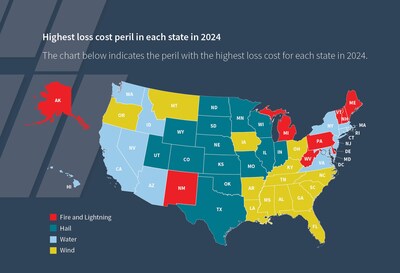LexisNexis U.S. Home Insurance Trends Report Highlights Rising Peril Severity as Catastrophic Claims Hit Seven-Year High
Rhea-AI Summary
LexisNexis Risk Solutions (RELX) released its 10th annual U.S. Home Trends Report on Oct 23, 2025, showing rising claim severity and catastrophe impact across U.S. home insurance.
Key metrics: All Peril severity rose 9% from 2023–2024 and was 21% above the long-term average; All Peril loss cost was 49.7% higher in 2024 vs 2019. Catastrophe claims were 42% of claims but 64% of losses in 2024. Notable moves: wind severity +23.5% and loss cost +30.7%; weather-related water loss cost +25.4%; hail loss cost +19% vs seven-year average.
Positive
- All Peril loss cost +49.7% versus 2019
- Catastrophe losses now represent 64% of total losses
- Wind loss cost +30.7% year-over-year
Negative
- All Peril severity rose 9% from 2023 to 2024
- Hail loss cost 19% above seven-year average
- Weather-related water loss cost +25.4% from 2023 to 2024
News Market Reaction 1 Alert
On the day this news was published, RELX declined 1.82%, reflecting a mild negative market reaction.
Data tracked by StockTitan Argus on the day of publication.
2025 report underscores the combined impact of hurricanes, hail and flooding as severity and loss costs continue to climb
Key Takeaways
-
All Peril severity increased
9% between 2023 and 2024, the highest in seven years, with 2024 breaking records set in 2023 as theU.S. experienced 27 climate disasters with$1 billion 21% above the long-term average. All Peril loss cost was49.7% higher in 2024 than in 2019. -
Catastrophe claims represented
42% of claims across all perils combined in 2024, while catastrophe losses increased to64% , another seven-year high signaling the growth of catastrophic events driving overall loss trends. -
Wind claims surged in 2024, with severity up
23.5% and loss costs jumping30.7% , fueled by Hurricanes Helene and Milton – two of the costliest events of the yeari. Losses peaked in September last year, the height of hurricane season. - Hail loss costs was
19% above the seven-year average in 2024 and nearly two-thirds of claims deemed catastrophic. Loss cost for other weather-related perils declined across Fire and Lightning (down3% ) and Non-Weather-Related Water (down4.3% ) from 2023 to 2024, while Weather Related Water rose25.4% .
"
All Peril Trends
- The
U.S. home insurance industry has experienced an upward trend in loss cost across all perils combined over the past seven years. - Severity reached its highest level in seven years in 2024, increasing
21% above the long-term average, likely driven by sustained inflationary pressures across all perils. While severity is high, frequency declined from 2023 to 2024 by11.6% . Colorado ranked highest in loss cost from catastrophic claims, whileNebraska had the highest loss cost of All Peril claims combined in 2024, driven by Hail losses.U.S. states with the highest combined catastrophe and non-catastrophe loss costs include Colo., Minn., Neb., La. and S.D. The lowest ranking states include Nev., N.H., W. Va., Vt. andMaine .
Hail Perils
- In 2024, the
U.S. experienced 5,373 hail events, down from 2023ii, but the loss costs continued their upward trend, sitting19% above the seven-year average. - The
U.S. experienced 11 severe weather/hail events with the cost of hail damage exceeding$3 billion $500 million - States with the highest impact of hail-related perils include Colo., Neb. and
Kansas . In 2024, the highest loss cost peril inTexas was hail over other weather events. - Hail peril seasonality over the past seven years continues, with April, May and June observing the highest frequency and loss cost.
Wind, Water, Fire and Lightning Perils
- Wind peril frequency rose
5.8% , along with loss cost increasing30.7% from 2023-2024. Severity increased23.5% year over year. - Fire and Lightning perils in 2024 saw decreases across loss cost (-
3% ) and frequency (-13.5). However, severity increased12.2% in 2024, likely due to major fires inNew York ,Connecticut andNew Mexico iv. Catastrophic claims made up10% of claims in 2024. - In 2024, there were 91 flash flood emergencies, a record-breaking number since 2003v, causing an increase in loss cost. Weather-Related Water loss cost increased
25.4% from 2023 to 2024, with claims severity up29.6% , while claims frequency declined3.2% .Oregon recorded the highest loss cost due to a severe winter storm with strong winds and freezing temperatures that led to burst water pipesvi. In 2024,64% of weather-related water claims were catastrophic.
Non-Weather-Related Perils
- Addressing claims related to water damage, such as leaking pipes and appliances, Non-Weather-Related Water perils decreased across loss cost (-
4.3% ) and frequency (-9.9% ) while severity increased (6.2% ) in 2024. - Theft loss cost and frequency decreased by
20% and20.9% , respectively, in 2024, and severity rose by1.1% , partially attributed to the rising cost of consumer goods such as high-end appliances and kitchenwarevii. - Liability loss cost increased
5.5% along with severity (18.8% ) in 2024, while frequency decreased by11.2% . - Other Perils, including physical damage claims not included elsewhere, extended coverage, damage to property of others, etc., saw a severity increase of
2.4% year over year. Loss cost, along with frequency, both declined24.6% and17.3% , respectively, from 2023 to 2024.
"The sharp rise in severity across multiple perils highlights the need for carriers to think beyond short-term rate actions," continued Hosfield. "Carriers that leverage more advanced property data insights–from roof condition to water damage risk–can make more informed underwriting decisions and stand a better chance of weathering the storm even as climate volatility and inflation continue to pressure the market."
Download the latest LexisNexis
About LexisNexis Risk Solutions
LexisNexis® Risk Solutions harnesses the power of data, sophisticated analytics platforms and technology solutions to provide insights that help businesses across multiple industries and governmental entities reduce risk and improve decisions to benefit people around the globe. Headquartered in metro Atlanta,
Media Contacts:
Chas Strong
LexisNexis Risk Solutions
Phone: +1.706.714.7083
Charles.Strong@lexisnexisrisk.com
i Adam B. Smith, "2024: An active year of
ii "Facts + Statistics: Hail," Insurance Information Institute, 2025, https://www.iii.org/fact-statistic/facts-statistics-hail
iii "Hail Statistics by State," YPA Public Adjusters, https://www.ypapublicadjusters.com/hail-statistics-by-state/
iv Hristina Byrnes, "Year In Review: The 25 Biggest Wildfires of 2024," Climate Crisis 247, https://climatecrisis247.com/gallery/year-in-review-the-25-biggest-wildfires-of-2024/
v Mary Gilbert, "An unprecedented number of flood emergencies have ravaged the US. It's a warning of what's to come," CNN, https://www.cnn.com/2024/10/25/weather/record-numbers-of-an-extreme-warning-show-the-reality-of-climate-change
vi Lillian Karabaic, Joni Auden Land and Courtney Sherwood, "Cold weather, power failures continue in aftermath of
vii Whizy Kim, "The surprising reason luxury goods are booming," Vox, https://www.vox.com/money/23728283/luxury-designer-boom-nike-lvmh-pandemic-le-creuset
![]() View original content to download multimedia:https://www.prnewswire.com/news-releases/lexisnexis-us-home-insurance-trends-report-highlights-rising-peril-severity-as-catastrophic-claims-hit-seven-year-high-302593013.html
View original content to download multimedia:https://www.prnewswire.com/news-releases/lexisnexis-us-home-insurance-trends-report-highlights-rising-peril-severity-as-catastrophic-claims-hit-seven-year-high-302593013.html
SOURCE LexisNexis Risk Solutions










